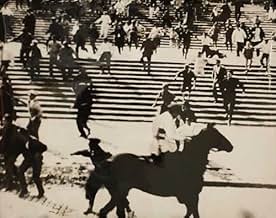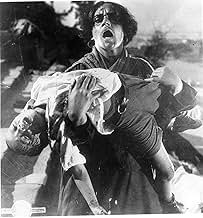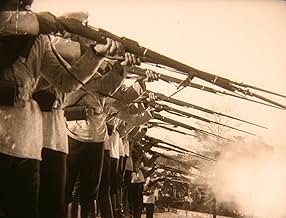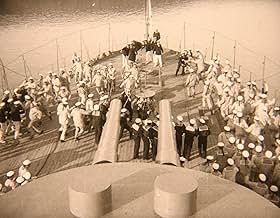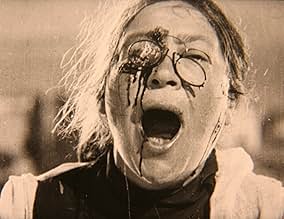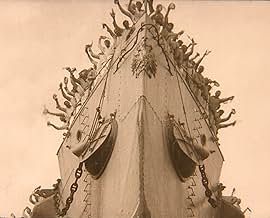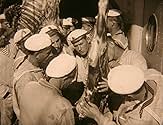NOTE IMDb
7,9/10
64 k
MA NOTE
Au milieu de la révolution russe de 1905, l'équipage du cuirassé Potemkine se révolte contre le régime brutal et tyrannique des officiers du navire. La manifestation de rue qui en résulte à ... Tout lireAu milieu de la révolution russe de 1905, l'équipage du cuirassé Potemkine se révolte contre le régime brutal et tyrannique des officiers du navire. La manifestation de rue qui en résulte à Odessa entraîne un massacre par la police.Au milieu de la révolution russe de 1905, l'équipage du cuirassé Potemkine se révolte contre le régime brutal et tyrannique des officiers du navire. La manifestation de rue qui en résulte à Odessa entraîne un massacre par la police.
- Réalisation
- Scénario
- Casting principal
- Récompenses
- 1 victoire au total
Ivan Bobrov
- Young Sailor Flogged While Sleeping
- (as I. Bobrov)
Nina Poltavtseva
- Woman With Pince-nez
- (as N. Poltavtseva)
Iona Biy-Brodskiy
- Student
- (as Brodsky)
Sergei Eisenstein
- Odessa Citizen
- (as Sergei M. Eisenstein)
Andrey Fayt
- Recruit
- (as A. Fait)
Résumé
Reviewers say 'Battleship Potemkin' is acclaimed for its pioneering montage and editing, significantly impacting cinema. The 1905 Russian Revolution portrayal, especially the Odessa Steps scene, is lauded for its potent visuals and emotional resonance. Many praise its technical innovations and contribution to filmmaking. However, some criticize its political propaganda and shallow character development. Nonetheless, 'Battleship Potemkin' is widely recognized as a cinematic masterpiece and a vital historical film.
Avis à la une
An epic of the Russian revolution, Battleship Potemkin, perhaps not so correctly historically, addresses the Russian revolution of 1905. With memorable scenes, especially the flag and the staircase scenes, Russian cinema is perhaps not so shy about showing violence. Which ends up enhancing and giving a more shocking experience when watching the film. A great movie considering the time it was released.
With workers striking in Russia, the crew of the battleship Potemkin feel a certain kinship for the plight of their brothers. When they are served rotting, maggot infested meat some of the crew object, only to find themselves singled out and placed in front of a firing squad. With the marines seconds away from firing the deadly shots, ordinary seaman Grigory Vakulinchuk steps into the breach and intervenes to save the men by appealing to the firing squad to ignore their orders. When the officers take their revenge and kill Vakulinchuk, all are bonded together in the struggle; a bond that reaches to the city of Odessa where the rebellion grows, leading to a bloody and historic series of events.
It is hard to imagine that anybody who has seen quite a few films in the past few decades would be unaware of this film, but it is perhaps understandable that fewer have had the opportunity to actually sit down and watch. I had never seen this film before but had seen countless references to it in other films and therefore considering it an important film to at least see once. The story is based on real events and this only serves to make it more interesting but even without this context it is still an engaging story. The story doesn't have much in the way of characters but it still brings out the brutality and injustice of events and it is in this that it hooked me surprisingly violent (implied more than modern gore) it demonising the actions and shows innocents falling at all sides in key scenes. The version I saw apparently had the original score (I'm not being snobby modern rescores could be better for all I know) and I felt it worked very well to match and improve the film's mood; dramatic, gentle or exciting, it all works very well.
The feel of the film was a surprise to me because it stood up very well viewed with my modern eyes. At one or two points the model work was very clearly model work but mostly the film is technically impressive. The masses of extras, use of ships and cities and just the way it captures such well organised chaos are all very impressive and would be even done today. What is more impressive with time though is how the film has a very strong and very clean style to it it is not as gritty and flat as many silent films of the period that I have seen; instead it is very crisp and feels very, very professional. Of course watching it in 2004 gives me the benefit of hindsight where I can look back over many films that have referenced the images or directors who have mentioned the film in interviews; but even without this 20:20 vision it is still possible to see how well done the film is and to note how memorable much of it is the steps and the firing squad scenes are two very impressive moments that are very memorable. The only real thing that might bug modern audiences is the acting; it isn't bad but silent acting is very different from acting with sound. Here the actors all over act and rely on their bodies to do much of their delivery word cards just don't do the emotional job so they have to make extra effort to deliver this.
Overall this is a classic film that has influenced many modern directors. The story is engaging and well worth hearing; the directing is crisp and professional, producing many scenes that linger in the memory; the music works to deliver the emotional edge that modern audiences would normally rely on acting and dialogue to deliver and the whole film is over all too quickly! An essential piece of cinema for those that claim to love the media but also a cracking good film in its own right.
It is hard to imagine that anybody who has seen quite a few films in the past few decades would be unaware of this film, but it is perhaps understandable that fewer have had the opportunity to actually sit down and watch. I had never seen this film before but had seen countless references to it in other films and therefore considering it an important film to at least see once. The story is based on real events and this only serves to make it more interesting but even without this context it is still an engaging story. The story doesn't have much in the way of characters but it still brings out the brutality and injustice of events and it is in this that it hooked me surprisingly violent (implied more than modern gore) it demonising the actions and shows innocents falling at all sides in key scenes. The version I saw apparently had the original score (I'm not being snobby modern rescores could be better for all I know) and I felt it worked very well to match and improve the film's mood; dramatic, gentle or exciting, it all works very well.
The feel of the film was a surprise to me because it stood up very well viewed with my modern eyes. At one or two points the model work was very clearly model work but mostly the film is technically impressive. The masses of extras, use of ships and cities and just the way it captures such well organised chaos are all very impressive and would be even done today. What is more impressive with time though is how the film has a very strong and very clean style to it it is not as gritty and flat as many silent films of the period that I have seen; instead it is very crisp and feels very, very professional. Of course watching it in 2004 gives me the benefit of hindsight where I can look back over many films that have referenced the images or directors who have mentioned the film in interviews; but even without this 20:20 vision it is still possible to see how well done the film is and to note how memorable much of it is the steps and the firing squad scenes are two very impressive moments that are very memorable. The only real thing that might bug modern audiences is the acting; it isn't bad but silent acting is very different from acting with sound. Here the actors all over act and rely on their bodies to do much of their delivery word cards just don't do the emotional job so they have to make extra effort to deliver this.
Overall this is a classic film that has influenced many modern directors. The story is engaging and well worth hearing; the directing is crisp and professional, producing many scenes that linger in the memory; the music works to deliver the emotional edge that modern audiences would normally rely on acting and dialogue to deliver and the whole film is over all too quickly! An essential piece of cinema for those that claim to love the media but also a cracking good film in its own right.
A milestone in cinematic history, 'Bronenosets Potyomkin' is one of the handful of great films out there that richly deserves to be called a classic. It was the picture that made Sergei M. Eisenstein a figurehead of film-making at the time. And today, it is still remembered as the wonderful piece of cinema it always has been.
'Potyomkin' is a film that NEEDS to be seen as one entity, not to be picked at. Don't just watch those clip shows where they only present the 'Odessa steps' sequence and then move on to 'Citizen Kane' or 'The Godfather', see it all in it's glorious 75-minute running time to really understand and enjoy it. Don't expect every infinitesimal detail to be perfect though, I mean the acting of the '20s silent era makes 'Scooby Doo' look like a master of understated realism, certain plot points may seem illogical and some of the battle sequences look dated, but it is still an immensely enjoyable movie.
The most memorable moments in the film are the mutiny on the battleship, Vakulinchuk's body falling off the ship, the sailor under the tent at the end of the pier, the mother holding her dead child, the baby carriage on the Odessa steps and the lion rising up to roar as further carnage ensues. For each new pair of eyes that look upon it, 'The Battleship Potemkin' comes alive once again.
'Potyomkin' is a film that NEEDS to be seen as one entity, not to be picked at. Don't just watch those clip shows where they only present the 'Odessa steps' sequence and then move on to 'Citizen Kane' or 'The Godfather', see it all in it's glorious 75-minute running time to really understand and enjoy it. Don't expect every infinitesimal detail to be perfect though, I mean the acting of the '20s silent era makes 'Scooby Doo' look like a master of understated realism, certain plot points may seem illogical and some of the battle sequences look dated, but it is still an immensely enjoyable movie.
The most memorable moments in the film are the mutiny on the battleship, Vakulinchuk's body falling off the ship, the sailor under the tent at the end of the pier, the mother holding her dead child, the baby carriage on the Odessa steps and the lion rising up to roar as further carnage ensues. For each new pair of eyes that look upon it, 'The Battleship Potemkin' comes alive once again.
This classic is filled with vivid images that stay in your mind after you have watched it, and there is a lot to appreciate in the way that the key scenes were set up and photographed. The visuals are so impressive that the movie's imperfections are usually not so noticeable, and they don't keep it from being a memorable film.
The movie certainly deserves the praise that it gets both for the influence that it has had, and for some ideas that for the time were most creative. The famed 'Odessa Steps' sequence alone demonstrates both fine technical skill and a keen awareness of how to drive home an image to an audience. It deserves to be one of cinema's best remembered sequences. Some of the other scenes also demonstrate, to a lesser degree, the same kind of skill.
It says a lot for how effective all of the visuals are that so many viewers think so highly of "Battleship Potemkin" despite a story that is sometimes heavy-handed, and despite characters and acting that are both rather thin. These features might simply stem from the collectivist philosophy that lies behind the story, and they are obscured most of the time by Eisenstein's unsurpassed ability to present pictures that viewers will not forget.
Despite the flaws, this is a movie that most fans of silent films, and anyone interested in the history of movies, will want to see. There's nothing else in its era that's quite like it.
The movie certainly deserves the praise that it gets both for the influence that it has had, and for some ideas that for the time were most creative. The famed 'Odessa Steps' sequence alone demonstrates both fine technical skill and a keen awareness of how to drive home an image to an audience. It deserves to be one of cinema's best remembered sequences. Some of the other scenes also demonstrate, to a lesser degree, the same kind of skill.
It says a lot for how effective all of the visuals are that so many viewers think so highly of "Battleship Potemkin" despite a story that is sometimes heavy-handed, and despite characters and acting that are both rather thin. These features might simply stem from the collectivist philosophy that lies behind the story, and they are obscured most of the time by Eisenstein's unsurpassed ability to present pictures that viewers will not forget.
Despite the flaws, this is a movie that most fans of silent films, and anyone interested in the history of movies, will want to see. There's nothing else in its era that's quite like it.
Sergei Eisenstein's silent masterpiece is a very influential and possibly the most famous landmark film ever made. Many, many memorable scenes, including one of the best and most powerful scenes in film history, the massacre on the Odessa steps. No film in our time has captured such power and amazement from one sequence. Along from being a landmark in film history, it also has a strong message on brotherhood and power hungry leaders. This one has stood the test of time and will for ever more.
Le saviez-vous
- AnecdotesThe film censorship boards of several countries felt this movie would spread communism. France imposed a ban after a brief run in 1925; it lifted it in 1953 after the death of Russian leader Joseph Stalin. The UK banned it until 1954.
- GaffesIn the Imperial squadron near the end of the film, there are close-ups of triple gun turrets of Gangut-class dreadnought. It possibly was made this way to show the power of Imperial fleet, but battleships of 1905 were much smaller pre-dreadnoughts, with twin turrets only, just like "Potemkin". "Ganguts" entered service in 1914.
- Versions alternativesSergei Eisenstein's premiere version opened with an unattributed quote from Leon Trotsky's "1905": The spirit of mutiny swept the land. A tremendous, mysterious process was taking place in countless hearts: the individual personality became dissolved in the mass, and the mass itself became dissolved in the revolutionary impetus. This quote was removed by Soviet censors in 1934, and replaced by a quotation from V.I. Lenin's "Revolutionary Days": Revolution is war. Of all the wars known in history, it is the only lawful, rightful, just and truly great war...In Russia this war has been declared and won. The original text was restored in 2004.
- ConnexionsEdited into Seeds of Freedom (1943)
Meilleurs choix
Connectez-vous pour évaluer et suivre la liste de favoris afin de recevoir des recommandations personnalisées
- How long is Battleship Potemkin?Alimenté par Alexa
Détails
- Date de sortie
- Pays d’origine
- Langues
- Aussi connu sous le nom de
- Battleship Potemkin
- Lieux de tournage
- Sevastopol, Crimea, Ukraine(battleship scenes)
- Société de production
- Voir plus de crédits d'entreprise sur IMDbPro
Box-office
- Montant brut aux États-Unis et au Canada
- 51 198 $US
- Week-end de sortie aux États-Unis et au Canada
- 5 641 $US
- 16 janv. 2011
- Montant brut mondial
- 62 723 $US
- Durée
- 1h 15min(75 min)
- Couleur
- Mixage
- Rapport de forme
- 1.33 : 1
Contribuer à cette page
Suggérer une modification ou ajouter du contenu manquant


